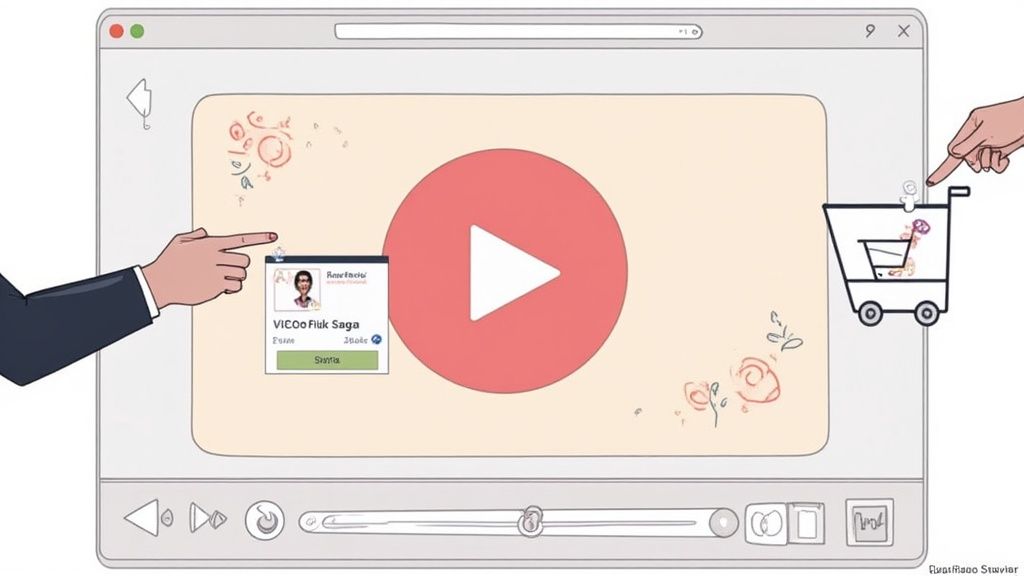Video Marketing Trends: What to Watch (updated 2025)



10 Key Video Marketing Trends to Dominate in 2025
The digital landscape is in constant flux, and video remains its most powerful current. As we move into 2025, understanding the key video marketing trends is no longer optional-it's essential for survival and growth. From the hyper-speed of vertical shorts on TikTok and Reels to the complex intelligence of AI-driven content, the way brands connect with audiences through video is undergoing a profound transformation.
This guide moves beyond buzzwords to provide actionable strategies and real-world examples for the 10 most critical trends you need to master. We'll delve into the tactical execution of shoppable video, the rise of authentic user-generated content, and the strategic importance of video SEO. These elements often reflect broader shifts in consumer behavior online. To gain a broader perspective on the evolving digital landscape, exploring these 10 social media trends to watch in 2025 can provide valuable context for understanding the shifts in video.
This article is designed for marketing directors, creative leads, and founders who need to implement effective video strategies now. You will learn not just what the prevailing trends are, but how to integrate them into your marketing funnel to drive tangible results. Whether you're a startup looking to make an impact or an established enterprise aiming to maintain a competitive edge, the insights that follow will define your brand's narrative, engagement, and ultimately, your success in the year ahead. We will cover everything from AI-generated video and interactive experiences to long-form video podcasts and purpose-driven storytelling, equipping you with the knowledge to not just participate, but to lead.
1. Short-Form Vertical Video Content
The undisputed champion of audience attention, short-form vertical video, continues its reign as a cornerstone of modern digital strategy. This format, encompassing content typically between 15 and 60 seconds, is tailor-made for mobile consumption on platforms like TikTok, Instagram Reels, and YouTube Shorts. Its explosive growth is a direct response to shrinking attention spans and the desire for quick, easily digestible, and highly shareable entertainment. This is one of the most critical video marketing trends for brands to master because it’s where consumer attention is most concentrated.

Brands like Duolingo have achieved legendary status by leveraging this trend, using their mascot to create humorous, relatable content that has amassed over five million followers. Similarly, Chipotle provides behind-the-scenes glimpses into their kitchens, turning simple food prep into viral content. The key is authenticity and value, delivered in a bite-sized package that resonates with a fast-scrolling audience.
How to Implement This Trend
To effectively harness the power of short-form video, focus on immediate impact and clarity. The goal is to stop the scroll instantly.
- Hook Viewers Immediately: You have less than three seconds to capture attention. Start with a compelling question, a surprising visual, or a bold statement.
- Embrace Trends Wisely: Use trending sounds and hashtags to increase discoverability, but ensure they align with your brand’s voice. A forced trend can appear inauthentic.
- Focus on a Single Message: Each video should have one clear takeaway. Whether it’s a quick tip, a product feature, or a brand story, avoid cluttering your message.
- Optimize for Silent Viewing: A significant portion of users watch videos without sound. Use on-screen text and clear captions to ensure your message lands, sound on or off.
Key Insight: The most successful short-form videos don't feel like traditional ads. They feel like native content, prioritizing entertainment, education, or inspiration over a hard sell. This approach builds community and trust, which are far more valuable long-term assets than a single conversion.
2. AI-Generated and AI-Enhanced Video Content
The integration of artificial intelligence is no longer science fiction; it's a practical and powerful force in video production. This trend involves using AI tools to create, edit, and enhance video content, dramatically reducing production costs and timelines. From generating realistic AI avatars to automating tedious editing tasks, AI is democratizing high-quality video creation. This evolution is one of the most transformative video marketing trends, allowing businesses to scale their content output without a proportional increase in budget or manpower.

Pioneering platforms are showcasing the tangible benefits of this technology. Companies like Synthesia enable brands such as Reuters to use AI avatars for delivering news updates, providing a scalable way to produce localized content. Similarly, creative tools like Runway ML are being adopted by content creators to generate surreal video clips from simple text prompts, pushing creative boundaries. Even established software like Adobe Premiere Pro now incorporates AI-powered features that automate tasks like color grading and audio clean-up, speeding up post-production workflows significantly.
How to Implement This Trend
Adopting AI in your video strategy doesn't require replacing your entire creative team. It’s about using smart tools to enhance efficiency and unlock new possibilities.
- Start with Enhancement Tools: Begin by integrating AI into your existing workflow. Use an AI video editor to automate tasks like captioning, object removal, or highlight reel creation from longer footage.
- Maintain Human Oversight: Use AI as a co-pilot, not the pilot. A human touch is essential for ensuring brand alignment, emotional nuance, and strategic creative direction. Review and refine all AI-generated output.
- Be Transparent with Your Audience: If using AI-generated avatars or voices, consider being transparent about it. Authenticity is key, and audiences often appreciate honesty, which helps manage expectations and build trust.
- Focus on Scaling, Not Replacing: Leverage AI to produce variations of a core video for different platforms or to create personalized content at scale. The goal is to amplify your team's creative capacity.
Key Insight: The true power of AI in video marketing lies in its ability to handle the repetitive, time-consuming tasks, freeing up human creators to focus on what they do best: strategy, storytelling, and building emotional connections. It's a tool for augmentation, not automation alone.
3. Interactive and Shoppable Video Experiences
The line between content and commerce is blurring, giving rise to interactive and shoppable video experiences that turn passive viewers into active participants. This format directly integrates clickable elements, product tags, and purchasing options into the video player itself, allowing consumers to explore products or even complete a purchase without ever leaving the video. This evolution transforms video from a top-of-funnel awareness tool into a powerful, full-funnel conversion engine, making it one of the most impactful video marketing trends for e-commerce and retail brands.

Major platforms are heavily invested in this trend. YouTube allows creators to tag products in their videos, while Instagram and TikTok have seamlessly integrated shopping tags into Reels and live streams. Beyond direct shopping, brands are experimenting with narrative interactivity, similar to Netflix's 'Black Mirror: Bandersnatch', to create engaging "choose your own adventure" style brand stories. Walmart has successfully used this on social media with shoppable recipe videos, where viewers can click on ingredients and add them directly to their cart.
How to Implement This Trend
To capitalize on this trend, you must create a seamless and intuitive user journey that adds value without disrupting the viewing experience.
- Start Simple with Product Tags: Begin by using the native shopping features on platforms like Instagram, TikTok, and YouTube. Tagging products in your videos is a low-effort, high-impact way to introduce shoppable functionality.
- Use Clear Calls-to-Action (CTAs): Don't assume viewers will know your video is interactive. Use on-screen text, graphics, or verbal cues like "Tap the link to shop this look" to guide them.
- Ensure Elements Enhance, Not Distract: Interactive elements should feel like a natural part of the content, not an intrusive pop-up ad. Place tags and links thoughtfully to complement the narrative.
- Test Across Devices: The user experience can vary significantly between desktop and mobile. Thoroughly test your interactive videos on multiple devices and platforms to ensure they function correctly everywhere.
Key Insight: The goal of interactive video isn't just to sell, but to shorten the customer journey. By removing friction and allowing for immediate action, you capitalize on the peak moment of interest, dramatically increasing the likelihood of engagement and conversion.
4. Live Streaming and Real-Time Engagement
Live streaming offers an unparalleled opportunity for raw, unedited interaction between a brand and its audience, fostering a sense of community and immediacy that pre-recorded content cannot replicate. This real-time broadcast format allows for direct engagement through live comments, Q&A sessions, and audience participation, creating an authentic and transparent brand experience. As audiences increasingly crave genuine connection, live streaming has solidified its place as one of the most powerful video marketing trends for building trust and loyalty.

This trend is highly versatile, with platforms like YouTube and Instagram Live hosting exclusive product launches and Q&A sessions, while LinkedIn Live has become a hub for professional webinars and thought leadership discussions. Fashion brands successfully use live shopping events to drive immediate sales, and Twitch streamers have built massive, dedicated communities by engaging with viewers during gameplay. The common thread is the direct, unfiltered connection that turns passive viewers into active participants.
How to Implement This Trend
Success in live streaming hinges on a balance of preparation and spontaneity, creating a professional yet authentic broadcast.
- Invest in Quality Production: While authenticity is key, poor audio or video quality can be distracting. A good microphone and stable camera setup are crucial for a professional impression.
- Prepare Talking Points, Not a Script: Have a clear outline of what you want to cover to stay on track, but allow for flexibility. The magic of live video comes from spontaneous interactions and off-the-cuff moments.
- Actively Engage Your Audience: Acknowledge viewers by name, answer questions as they come in, and respond to comments. Make the audience feel like they are part of a conversation, not just watching a presentation.
- Promote Before and Repurpose After: Build anticipation by promoting your live stream across all channels in the days leading up to the event. Afterward, edit the recording into shorter clips for social media to extend its reach and value.
Key Insight: Live streaming’s primary value isn't just the event itself, but the community it builds. The unscripted nature of live video breaks down corporate barriers, showing the human side of a brand and fostering a level of trust that is difficult to achieve with polished, pre-produced content.
5. User-Generated Content (UGC) and Authentic Storytelling
The demand for authenticity has shifted the spotlight from polished, brand-produced ads to raw, real content created by actual customers. User-Generated Content (UGC) leverages videos made by your audience, showcasing genuine experiences, reviews, and testimonials. This approach builds immense trust and credibility because the message comes from a peer, not the company itself. This is one of the most powerful video marketing trends for fostering community and converting skeptical buyers.
GoPro has built its entire marketing empire on this concept, transforming customer adventure footage into compelling ads that showcase product durability and quality in the real world. Similarly, beauty brand Glossier features customer makeup tutorials and reviews, creating a relatable and inclusive brand image. Airbnb frequently highlights host and guest stories, using authentic narratives to sell experiences, not just stays. The success of UGC lies in its ability to provide social proof at scale.
How to Implement This Trend
Effectively incorporating UGC requires a structured yet flexible approach that encourages participation while maintaining brand safety.
- Create Clear Guidelines and Hashtags: Launch a campaign with a unique, memorable hashtag. Provide clear instructions on the type of content you're looking for, but allow room for creativity.
- Incentivize Participation: Encourage submissions by offering rewards, discounts, or the chance to be featured on your official channels. Contests and giveaways are a fantastic way to generate a high volume of content.
- Showcase Diverse Voices: Actively feature a wide range of customers from different backgrounds and with different experiences. This reinforces authenticity and makes your brand feel more inclusive and relatable.
- Curate and Secure Permissions: Always obtain explicit permission before using a customer's content. Curate submissions carefully to ensure they align with your brand values and quality standards.
Key Insight: UGC is not just about getting free content; it’s about building a community that actively participates in your brand's story. By turning customers into creators, you create powerful advocates whose authentic endorsements are more persuasive than any traditional advertisement.
6. Video Podcasting and Long-Form Educational Content
While short-form video captures attention, long-form content builds authority and deepens audience relationships. This trend involves creating extended video content, such as podcasts, detailed tutorials, webinars, and in-depth interviews. This format is designed for viewers seeking substantial, valuable information, allowing brands to establish themselves as thought leaders and build lasting trust. This is one of the more strategic video marketing trends for cultivating a loyal, highly-engaged community.
The explosive popularity of video podcasts, exemplified by giants like The Joe Rogan Experience on Spotify, showcases the demand for deep-dive conversations. On the educational front, platforms like HubSpot Academy and MasterClass have built entire business models around comprehensive video courses that provide immense value. These brands understand that investing time in educating their audience creates a powerful bond that transcends transactional relationships.
How to Implement This Trend
Success in long-form video hinges on delivering sustained value that justifies the viewer's time commitment. The content must be as engaging as it is informative.
- Focus on Substantive Value: Your content must answer a deep need, solve a complex problem, or provide expert-level insight. Superficial information won’t hold an audience for 30-60 minutes.
- Enhance with Visuals: Use screen recordings, B-roll footage, animated graphics, and on-screen text to break up talking-head segments and illustrate complex points.
- Structure for Engagement: Break longer videos into clear chapters or segments with timestamps. This improves the viewing experience and makes your content more accessible.
- Repurpose Strategically: Your long-form video is a content goldmine. Extract key moments, compelling quotes, and quick tips to create dozens of short-form clips for social media promotion.
Key Insight: Long-form content is an investment in audience education and brand authority. While it may not drive immediate conversions, it builds a foundation of trust and expertise that pays dividends in customer loyalty and lifetime value. Learn more about crafting effective educational video marketing on moonb.io.
7. Personalized and Data-Driven Video Content
Moving beyond one-size-fits-all messaging, personalized video uses viewer data to deliver content that is uniquely relevant to the individual. This approach leverages analytics, user behavior, and demographic information to customize everything from the products shown to the call-to-action offered. By treating viewers as individuals rather than a monolith, brands can create a significantly deeper and more resonant connection. This is one of the most powerful video marketing trends for boosting engagement and conversion rates because it speaks directly to a user's specific needs and interests.
The masters of this domain are streaming and e-commerce giants. Netflix uses sophisticated algorithms to serve personalized video trailers and even custom thumbnails based on your viewing history. Similarly, Amazon dynamically generates video ads showcasing products you’ve recently viewed, while Spotify’s annual "Wrapped" campaign creates a personalized video recap of your listening habits, a viral sensation year after year. These examples prove that data-driven video feels less like an ad and more like a helpful, curated service.
How to Implement This Trend
To leverage data-driven video, you must start with a clear understanding of your audience segments and have a solid data infrastructure. The goal is to make the viewer feel seen and understood.
- Use First-Party Data: Prioritize data you collect directly from your audience, such as purchase history, website behavior, or email engagement. This is more accurate and respects user privacy.
- Start with Segmentation: Before attempting one-to-one personalization, group your audience into meaningful segments. You can create different video versions for new customers versus loyal repeat buyers, for example.
- Test Personalization Elements: Systematically test which personalized elements drive the best results. Experiment with dynamic CTAs, personalized greetings, or videos that feature location-specific imagery.
- Ensure Privacy Compliance: Be transparent about how you use data and ensure your practices comply with regulations like GDPR and CCPA. Trust is paramount; a breach of privacy will negate any benefits.
Key Insight: Effective personalization is a balance between being helpful and being intrusive. The goal isn't to show the customer you know everything about them, but to use what you know to provide genuine value. When done right, it enhances the user experience and makes your brand an indispensable resource.
8. 360-Degree and Virtual Reality (VR) Video Content
Immersive video is no longer science fiction; it’s a powerful tool for creating unforgettable brand experiences. 360-degree and Virtual Reality (VR) content places the viewer directly inside the environment, offering an unparalleled level of engagement by allowing them to control their perspective and explore a digital space. This shift from passive viewing to active participation creates a deep, memorable connection with the audience. As hardware like the Meta Quest becomes more accessible, these immersive video marketing trends are moving from niche experiments to viable strategies for forward-thinking brands.
The applications are incredibly diverse and impactful. Real estate agents use 360-degree videos to offer virtual property tours, allowing potential buyers to explore homes from anywhere in the world. Similarly, National Geographic transports viewers to remote jungles and deep oceans, creating educational content that feels like a genuine expedition. Brands like BMW have also pioneered this space with virtual showroom experiences, letting customers explore the interior of a new car without ever leaving their living room.
How to Implement This Trend
Diving into immersive video requires a focus on the user experience to ensure the technology enhances, rather than complicates, the message.
- Start with 360-Degree Video: Before investing in full-scale VR development, begin with 360-degree videos. They are more affordable to produce and can be viewed on standard devices like smartphones and desktops via platforms like YouTube 360, making them more accessible to a wider audience.
- Focus on Experiences that Benefit from Immersion: This format works best when it adds value that a standard video cannot. Think virtual tours, event experiences, product demonstrations, or "behind-the-scenes" access that makes the viewer feel physically present.
- Optimize for Mobile Viewing: Most 360-degree content is consumed on mobile devices, where users can physically move their phones to look around. Ensure your video is high-resolution and that interactive elements are easy to use on a smaller screen.
- Provide Clear Instructions: Guide your viewers. Use on-screen text or audio cues to explain how to navigate the environment. A simple prompt like "Look up!" or "Click here to move forward" can make the experience far more intuitive and enjoyable.
Key Insight: The goal of immersive video is not just to show something, but to make the viewer feel something. Successful 360/VR content creates a sense of presence and agency, transforming a marketing message into a personal memory. It's about letting the user discover your brand story on their own terms.
9. Video SEO and Search Optimization
Creating great video content is only half the battle; ensuring it gets discovered is the other. Video SEO involves strategically optimizing your content for both search engines like Google and platform-specific algorithms like YouTube's. This practice is crucial for driving organic traffic, as search engines increasingly feature video carousels and rich results directly on the search engine results page (SERP). This is one of the most powerful video marketing trends because it transforms your video assets into long-term lead-generation tools.
HubSpot excels at this, creating educational videos that rank for high-intent business keywords, capturing valuable search traffic. Similarly, recipe channels often dominate search results for specific dishes by meticulously optimizing their titles, descriptions, and structured data. The goal is to align your video content with the precise terms and questions your target audience is searching for.
How to Implement This Trend
Effective video SEO requires a proactive, search-first mindset from the very beginning of the production process.
- Conduct Keyword Research First: Before you even press record, identify the keywords and phrases your audience uses. Create content that directly answers their search queries.
- Optimize Your Metadata: Your video title, description, and tags are critical ranking signals. Craft a compelling, keyword-rich title and a detailed description that includes relevant terms and timestamps.
- Create a Compelling Thumbnail: Your thumbnail is your video's billboard. Design a custom, high-contrast thumbnail with text overlay that entices users to click, as click-through rate is a major ranking factor. For those focusing on organic reach, exploring YouTube video optimization tools can significantly improve your search rankings.
- Add Transcripts and Closed Captions: Search engines can't watch your video, but they can read it. Uploading a full transcript and accurate captions gives them crawlable text, helping them understand your content's context and relevance. To dive deeper, you can learn more about a comprehensive video marketing checklist on moonb.io.
Key Insight: Video SEO isn't just about pleasing algorithms; it's about improving the user experience. Well-optimized videos are easier to find, understand, and consume. By focusing on providing clear, accessible, and highly relevant content, you naturally align with what search engines want to promote.
10. Video Storytelling for Brand Purpose and Social Impact
Beyond products and services, modern consumers are increasingly drawn to brands that stand for something more. Video storytelling for brand purpose allows companies to connect with audiences on a deeper, emotional level by showcasing their commitment to social causes, environmental sustainability, and core values. This approach moves beyond traditional advertising to build a narrative around a brand’s mission and its positive impact on the world. This is one of the more profound video marketing trends as it focuses on building lasting loyalty through shared values.
Patagonia has masterfully used this strategy, producing compelling documentaries about environmental activism that resonate with their target audience. Similarly, Dove’s long-running "Campaign for Real Beauty" uses powerful video stories to champion body positivity and challenge narrow beauty standards. These campaigns work because they authentically reflect the brand's core mission, turning passive viewers into passionate advocates. For more inspiration, you can find excellent brand story examples on moonb.io.
How to Implement This Trend
To create purpose-driven video content that resonates, the focus must be on authenticity and genuine impact rather than performative gestures.
- Ensure Genuine Commitment: Your video narrative must be backed by real-world action. Audiences can quickly spot inauthenticity, so ensure your company's values and operations align with the message you're promoting.
- Focus on Human Stories: Abstract concepts like "social responsibility" are best communicated through personal, human-centric stories. Showcase the real people and communities your initiatives affect to create a powerful emotional connection.
- Engage with Communities: Don't just talk about a cause; involve the community you aim to support. Co-create content with activists, non-profits, or affected individuals to lend credibility and depth to your story.
- Measure Impact Holistically: Success here isn't just about views or shares. Track sentiment, community engagement, and brand perception to understand the true impact of your purpose-driven content.
Key Insight: Purpose-driven video is not a short-term sales tactic; it's a long-term brand-building strategy. When done correctly, it builds a powerful sense of community and trust that can insulate a brand from market fluctuations and foster deep, lasting customer loyalty.
Top 10 Video Marketing Trends Compared
Integrating Tomorrow's Trends into Today's Strategy
Navigating the dynamic landscape of video marketing can feel like charting a course through constantly shifting seas. As we've explored, the dominant currents for 2024 and beyond are not just fleeting fads; they represent fundamental changes in how audiences consume content and connect with brands. From the snackable, high-impact nature of short-form vertical video to the immersive depth of 360-degree experiences, each trend offers a unique pathway to capture attention, build trust, and drive action.
The central theme connecting these video marketing trends is the demand for a more human, responsive, and value-driven approach. Your audience no longer tolerates a one-size-fits-all message. They expect content that understands their needs, respects their time, and engages them on their preferred platforms, whether through a real-time Q&A on a live stream or a shoppable video that seamlessly blends entertainment with e-commerce.
Synthesizing the Trends: From Insights to Action
Merely acknowledging these trends is not enough. The true competitive advantage lies in strategically integrating them into a cohesive and agile marketing ecosystem. Think of it not as a checklist to complete, but as a palette of creative tools to be blended and applied with purpose.
- Combine Authenticity with Technology: Leverage AI-enhanced tools to scale the production of personalized video content, but ground it in the authentic voice of User-Generated Content (UGC). Use AI to analyze which UGC resonates most, then amplify those themes in your broader campaigns.
- Bridge Short-Form and Long-Form: Use compelling vertical video clips as gateways, teasing the valuable, in-depth knowledge shared in your video podcasts or long-form educational content. This creates a content funnel that caters to both fleeting attention spans and audiences seeking deep expertise.
- Make Every Video Actionable: Enhance your brand storytelling videos with interactive elements. A powerful video about your social impact mission can be made even more effective with clickable links to donation pages or volunteer sign-ups, turning passive viewers into active participants.
- Optimize for Discovery: The principles of Video SEO are not just for YouTube. Apply search optimization tactics to your short-form video descriptions, your live stream titles, and even the metadata of your VR content to ensure your investment is discoverable across the digital ecosystem.
Your Strategic Roadmap for Implementation
To avoid becoming overwhelmed, focus on a phased approach. Start by identifying the one or two trends that align most closely with your immediate business goals and your target audience's behavior. Are you a B2B startup aiming to establish thought leadership? Prioritizing video podcasting and personalized, data-driven outreach could be your most effective first step. Are you a direct-to-consumer brand looking to boost sales? A focus on shoppable video and authentic UGC will likely yield the fastest returns.
The key is to build a scalable content engine. The modern marketing team must be a prolific creator, capable of producing a diverse array of video assets tailored for different platforms and funnel stages. This requires a flexible and efficient creative infrastructure that can move at the speed of culture without sacrificing quality. Mastering these video marketing trends is no longer optional; it is the definitive factor in building a resilient, relevant, and revolutionary brand that not only captures attention today but also commands loyalty tomorrow. The future of video isn't just coming, it's already here, and it rewards those who are prepared to create, connect, and convert.
Struggling to produce the diverse, high-quality video content needed to capitalize on these trends? Moonb provides a scalable, on-demand creative team to help you execute your entire video strategy, from short-form social clips to polished brand stories. Get the reliable creative output you need to stay ahead by visiting Moonb today.






